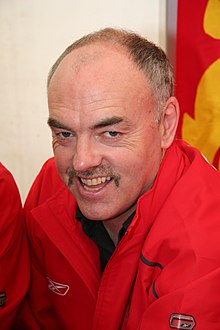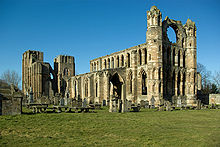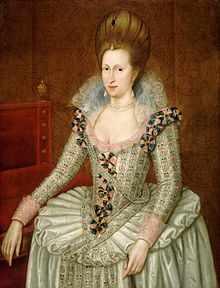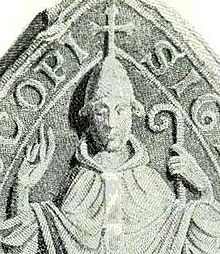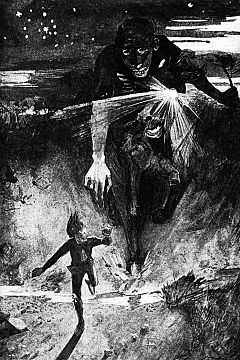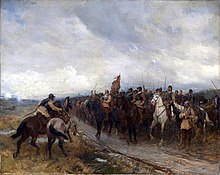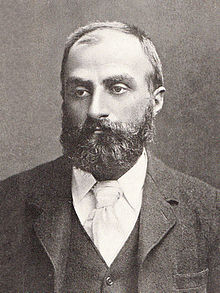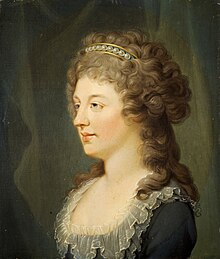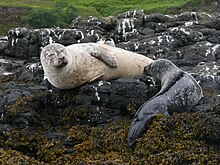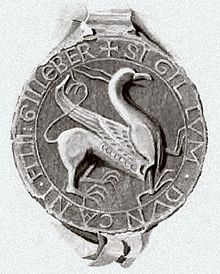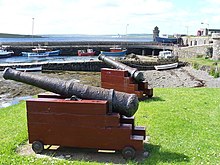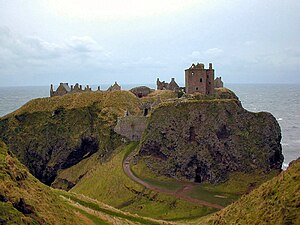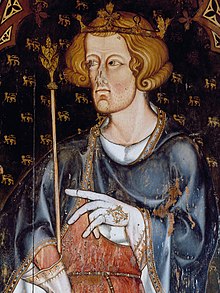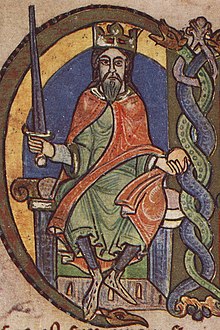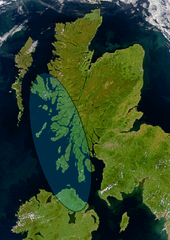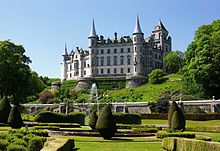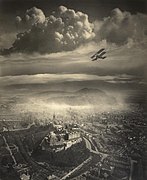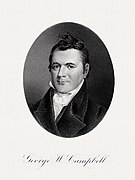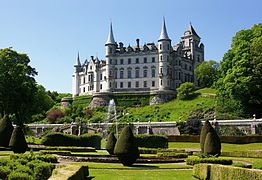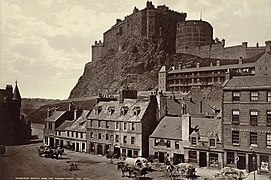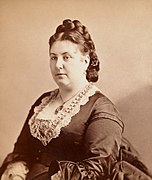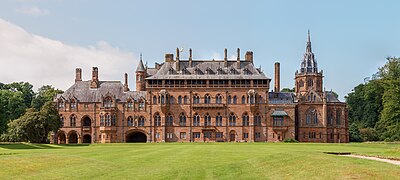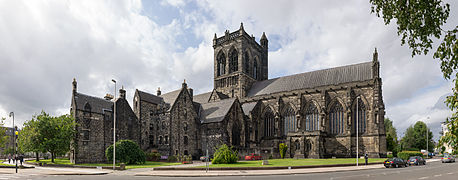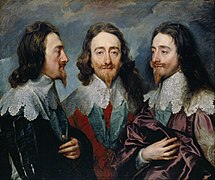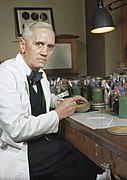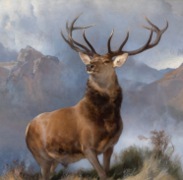Portal:Scotland/Featured
The Scotland Portal
View from An Teallach
| Main Page | Selected articles 1 | Selected articles 2 | Selected biographies | Selected quotes | Selected pictures | Featured Content | Categories & Topics |
Selection of featured articles
Selection of good articles
Doune Castle is a medieval stronghold near the village of Doune, in the Stirling council area of central Scotland and the historic county of Perthshire. The castle is sited on a wooded bend where the Ardoch Burn flows into the River Teith. It lies 8 miles (13 kilometres) northwest of Stirling, where the Teith flows into the River Forth. Upstream, 8 miles (13 kilometres) further northwest, the town of Callander lies at the edge of the Trossachs, on the fringe of the Scottish Highlands.
Recent research has shown that Doune Castle was originally built in the thirteenth century, then probably damaged in the Scottish Wars of Independence, before being rebuilt in its present form in the late 14th century by Robert Stewart, Duke of Albany (c. 1340–1420), the son of King Robert II of Scots, and Regent of Scotland from 1388 until his death. Duke Robert's stronghold has survived relatively unchanged and complete, and the whole castle was traditionally thought of as the result of a single period of construction at this time. The castle passed to the crown in 1425, when Albany's son was executed, and was used as a royal hunting lodge and dower house. In the later 16th century, Doune became the property of the Earls of Moray. The castle saw military action during the Wars of the Three Kingdoms and Glencairn's rising in the mid-17th century, and during the Jacobite risings of the late 17th century and 18th century. By 1800 the castle was ruined, but restoration works were carried out in the 1880s, prior to its passing into state care in the 20th century. It is now maintained by Historic Environment Scotland. (Full article...)
The National is a Scottish daily newspaper owned by Newsquest. It began publication on 24 November 2014, and was the first daily newspaper in Scotland to support Scottish independence. Launched as a response to calls from Newsquest's readership for a pro-independence paper in the wake of the 2014 Scottish independence referendum, it is a sister paper of The Herald, and is edited by Laura Webster. Initially published on weekdays, a Saturday edition was added in May 2015. The National is printed in tabloid format, and is also available via online subscription.
Details of its launch were announced on 21 November, with further information given at a Scottish National Party (SNP) rally the following day. It was launched on a five-day trial basis against the backdrop of a general decline in newspaper sales, with an initial print-run of 60,000 copies for its first edition, but this was increased the following day as a result of public demand, and Newsquest decided to print it on a permanent basis after healthy sales continued throughout the first week. The first front page carried a story about charities urging devolution of powers over welfare legislation to Scotland. (Full article...)
Details of its launch were announced on 21 November, with further information given at a Scottish National Party (SNP) rally the following day. It was launched on a five-day trial basis against the backdrop of a general decline in newspaper sales, with an initial print-run of 60,000 copies for its first edition, but this was increased the following day as a result of public demand, and Newsquest decided to print it on a permanent basis after healthy sales continued throughout the first week. The first front page carried a story about charities urging devolution of powers over welfare legislation to Scotland. (Full article...)
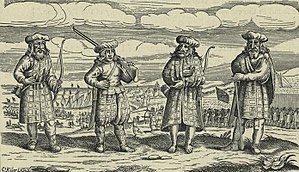
Warfare in early modern Scotland includes all forms of military activity in Scotland or by Scottish forces, between the adoption of new ideas of the Renaissance in the early sixteenth century and the military defeat of the Jacobite movement in the mid-eighteenth century.
In the late Middle Ages, Scottish armies were assembled on the basis of common service, feudal obligations and money contracts of bonds of manrent. In 1513 these systems produced a large and formidable force, but in the mid-sixteenth century there were difficulties in recruitment. Individuals were expected to provide their own equipment, including axes and pole arms. Highland troops often brought bows and two-handed swords. Heavy armour was abandoned after the Flodden campaign. Highland lords tended to continue to use lighter chainmail and ordinary highlanders dressed in the plaid. The crown took an increasing role in the supply of equipment. The pike replaced the spear and the Scots began to convert from the bow to gunpowder firearms. Feudal heavy cavalry were replaced with light horse, often drawn from the Borders. James IV established a gun foundry in 1511 and gunpowder weaponry fundamentally altered the nature of castle architecture. In the 1540s and 1550s, Scotland was given a defended border of earthwork forts and additions to existing castles. (Full article...)
The 2012 Scottish Cup Final was the 127th final of the Scottish Cup. The match took place at Hampden Park on 19 May 2012 and was contested by the Edinburgh derby rivals, Hibernian (Hibs) and Heart of Midlothian (Hearts). It was Hibs' 12th Scottish Cup Final and Hearts' 14th. It was also the first time the clubs had met in a Scottish Cup Final since 1896.
As Scottish Premier League (SPL) clubs, Hibs and Hearts both entered the competition in the fourth round. Hibs won all four of their ties at the first attempt, defeating two other SPL clubs and two Scottish Football League clubs. After winning against Junior club Auchinleck Talbot in the fourth round, Hearts defeated three other SPL clubs to reach the final. Hearts needed a replay to eliminate St Johnstone then they beat St Mirren, then beat cup holders Celtic in the semi-final. (Full article...)
As Scottish Premier League (SPL) clubs, Hibs and Hearts both entered the competition in the fourth round. Hibs won all four of their ties at the first attempt, defeating two other SPL clubs and two Scottish Football League clubs. After winning against Junior club Auchinleck Talbot in the fourth round, Hearts defeated three other SPL clubs to reach the final. Hearts needed a replay to eliminate St Johnstone then they beat St Mirren, then beat cup holders Celtic in the semi-final. (Full article...)
Dunrobin Castle (mostly 1835–1845 — present) is a stately home in Sutherland, in the Highland area of Scotland, as well as the family seat of the Earl of Sutherland, Chief of the Clan Sutherland. It is located one mile (1.5 kilometres) north of Golspie and approximately five miles (eight kilometres) south of Brora, overlooking the Dornoch Firth.
Dunrobin's origins lie in the Middle Ages, but most of the present building and the gardens were added by Sir Charles Barry between 1835 and 1850. Some of the original building is visible in the interior courtyard, despite a number of expansions and alterations that made it the largest house in the north of Scotland. After being used as a boarding school for seven years, it is now open to the public. (Full article...)

A shieling (Scottish Gaelic: Àirigh) is a hut or collection of huts on a seasonal pasture high in the hills, once common in wild or sparsely populated places in Scotland. Usually rectangular with a doorway on the south side and few or no windows, they were often constructed of dry stone or turf. More loosely, the term may denote a seasonal mountain pasture for the grazing of cattle in summer. Seasonal pasturage implies transhumance between the shieling and a valley settlement in winter. Many Scottish songs have been written about life in shielings, often concerning courtship and love. The ruins of shielings are abundant landscape features across Scotland, particularly the Highlands. (Full article...)
James Innes (c. 1700 – 5 September 1759) was an American military commander and political figure in the Province of North Carolina who led troops both at home and abroad in the service of the Kingdom of Great Britain. Innes was given command of a company of North Carolina's provincial soldiers during the War of Jenkins' Ear, and served as Commander-in-Chief of all colonial soldiers in the Ohio River Valley in 1754 during the French and Indian War. After resigning his commission in 1756, Innes retired to his home on the Cape Fear River. A bequest made by Innes upon his death lead to the establishment of Innes Academy in Wilmington, North Carolina. (Full article...)
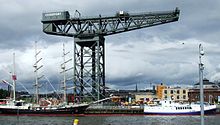
The Finnieston Crane or Stobcross Crane is a disused giant cantilever crane in the centre of Glasgow, Scotland. It is no longer operational, but is retained as a symbol of the city's engineering heritage. The crane was used for loading cargo, in particular steam locomotives, onto ships to be exported around the world.
It is one of four such cranes on the River Clyde, a fifth one having been demolished in 2007, and one of only eleven giant cantilever cranes remaining worldwide. (Full article...)
Partick Thistle Football Club are a professional football club from Glasgow, Scotland. Despite their name, the club are based at Firhill Stadium in the Maryhill area of the city, and have not played in Partick since 1908. The club have been members of the Scottish Professional Football League (SPFL) since its formation in 2013, having previously been members of the Scottish Football League. In the 2020–21 season, Thistle won Scottish League One, the third tier of the SPFL structure, and returned to the Scottish Championship, having been relegated from there in 2019–20.
Since 1936, Thistle have played in their distinctive red-and-yellow jerseys of varying designs, with hoops, stripes and predominantly yellow tops with red trims having been used, although in 2009 a centenary kit was launched in the original navy-blue style to commemorate 100 years at Firhill. Since 1908 the club have won the Scottish Second Division (third tier, now Scottish League One) twice and the Scottish First Division (second tier, now the Scottish Championship) six times, most recently in 2013. Thistle have won the Scottish Cup and the Scottish League Cup in 1921 and 1971 respectively. (Full article...)
Since 1936, Thistle have played in their distinctive red-and-yellow jerseys of varying designs, with hoops, stripes and predominantly yellow tops with red trims having been used, although in 2009 a centenary kit was launched in the original navy-blue style to commemorate 100 years at Firhill. Since 1908 the club have won the Scottish Second Division (third tier, now Scottish League One) twice and the Scottish First Division (second tier, now the Scottish Championship) six times, most recently in 2013. Thistle have won the Scottish Cup and the Scottish League Cup in 1921 and 1971 respectively. (Full article...)

Thurso (pronounced /ˈθɜːrzoʊ/; Scots: Thursa, Scottish Gaelic: Inbhir Theòrsa [ˈiɲɪɾʲ ˈhjɔːrˠs̪ə]) is a town and former burgh on the north coast of the Highland council area of Scotland. Situated in the historical County of Caithness, it is the northernmost town on the island of Great Britain. From a latitudinal standpoint, Thurso is located further north than the southernmost point of Norway and in addition lies more than 500 miles (800 km) north of London.
It lies at the junction of the north–south A9 road and the west–east A836 road, connected to Bridge of Forss in the west and Castletown in the east. The 34-mile (55 km) River Thurso flows through the town and into Thurso Bay and the Pentland Firth. The river estuary serves as a small harbour. At the 2011 Census, Thurso had a population of 7,933. The population of the larger Thurso civil parish including the town and the surrounding countryside was estimated to be 12,057 in 2021. (Full article...)

The flag of Scotland (Scottish Gaelic: bratach na h-Alba; Scots: Banner o Scotland, also known as St Andrew's Cross or the Saltire) is the national flag of Scotland, which consists of a white saltire defacing a blue field. The Saltire, rather than the Royal Standard of Scotland, is the correct flag for all private individuals and corporate bodies to fly. It is also, where possible, flown from Scottish Government buildings every day from 8:00 am until sunset, with certain exceptions.
Use of the flag is first recorded with the illustration of a heraldic flag in Sir David Lyndsay of the Mount's Register of Scottish Arms, c. 1542. It is possible that this is based on a precedent of the late 15th century, the use of a white saltire in the canton of a blue flag reputedly made by Queen Margaret, wife of James III (1451–1488). (Full article...)

The economy of Scotland in the early modern era encompasses all economic activity in Scotland between the early sixteenth century and the mid-eighteenth. The period roughly corresponds to the early modern era in Europe, beginning with the Renaissance and Reformation and ending with the last Jacobite risings and the beginnings of the Industrial Revolution.
At the beginning of this period Scotland was a relatively poor country, with difficult terrain and limited transport, relying on traditional agricultural methods of jointly run fermtouns and bailes. The late sixteenth century saw economic distress, inflation and famine, but also the beginnings of industrial production as new techniques were imported to the country. The seventeenth century saw economic development led by trade, particularly to England and with the Americas, despite the problems of tariffs. There was continued occasional famine, culminating in the "seven ill years" of the 1690s. Attempts to establish a Scottish colony in Central America as part of the Darién scheme ended in disaster in the 1690s. After the Union with England in 1707 there was increasing introduction of improvements in agriculture that helped improve the food supply and growing trade with the Americans that produced the Tobacco Lords of Glasgow, the trade in sugar and rum and Paisley in cloth. There was also the development of financial institutions, including the Bank of Scotland, Royal Bank of Scotland and British Linen Company, and improvements in roads both of which would help facilitate the Industrial Revolution that would accelerate in the late eighteenth century. (Full article...)
East Kirkton Quarry, or simply East Kirkton, is a former limestone quarry in West Lothian, Scotland, now a renowned fossil site. The quarry is known for terrestrial and freshwater fossils about 335 million years old, from the late Viséan stage of the Mississippian subperiod (Early Carboniferous Period). The quarry is a 200-meter-long (~650 ft) depression located in the town of Bathgate. Geographically, it sits at the Bathgate Hills near the center of the Midland Valley, a fossil-rich region of southeast Scotland. The site is dominated by volcanic tuff, limestone, and silica deposits of large freshwater lakes associated with hot springs and local basaltic (high-iron) volcanism. Three geological intervals are exposed: the East Kirkton Limestone (oldest), Little Cliff Shale (middle), and Geikie Tuff (youngest).
The East Kirkton Limestone in particular has produced numerous well-preserved fossils of tetrapods (four-limbed vertebrates) and arthropods (multi-legged chitinous invertebrates like millipedes and arachnids). East Kirkton had been ignored by paleontologists since the 1840s, but Scottish fossil collector Stan Wood managed to procure the land in 1985, sparking a rush of scientific interest. New species from East Kirkton have been named on a regular basis since 1990, and nearly all of these species have been found nowhere else. Notable discoveries include Westlothiana (one of the most reptile-like Mississippian tetrapods), Balanerpeton (a common early representative of amphibians in the group Temnospondyli), and Pulmonoscorpius (the largest known terrestrial scorpion). The East Kirkton area represents an unconventional environment: dry woodlands and mineral-rich lakes nestled among volcanic cinder cones. Aquatic animals, though not uncommon, are less diverse than those found in the swampy coal forests and coastal sediments prevalent at other Scottish Carboniferous fossil sites. The prevalence of terrestrial organisms represents a broader trend of decreasing reliance on an amphibious lifestyle during the Carboniferous Period. (Full article...)
The 1884 FA Cup final was a football match between Blackburn Rovers and Queen's Park contested on 29 March 1884 at the Kennington Oval. It was the showpiece match of English football's primary cup competition, the Football Association Challenge Cup (better known as the FA Cup), it was the 13th Cup final. It was the first time that a Scottish team reached the final of the tournament, with Queen's Park knocking out the previous holders of the trophy en route.
Both teams received protests from the defeated teams following the semi-final matches, but each were turned down by the Football Association. By the time the match was played, Queen's Park had already been awarded the Scottish Cup after Vale of Leven declined to participate in the final. Prior to the match there were temporary stands built at the Oval as the Pavilion was reserved for members of the Surrey County Cricket Club. There was a record breaking attendance at the match, with between 10,000 and 12,000 fans attending making it the most attended match in London; special trains were laid on by the railways to transport spectators from Lancashire. (Full article...)
Both teams received protests from the defeated teams following the semi-final matches, but each were turned down by the Football Association. By the time the match was played, Queen's Park had already been awarded the Scottish Cup after Vale of Leven declined to participate in the final. Prior to the match there were temporary stands built at the Oval as the Pavilion was reserved for members of the Surrey County Cricket Club. There was a record breaking attendance at the match, with between 10,000 and 12,000 fans attending making it the most attended match in London; special trains were laid on by the railways to transport spectators from Lancashire. (Full article...)
Ragnall mac Bárid ua Ímair (Old Norse: Rǫgnvaldr [ˈrɔɣnˌwɑldz̠], died 921) or Rægnald was a Viking leader who ruled Northumbria and the Isle of Man in the early 10th century. He was a grandson of Ímar and a member of the Uí Ímair. Ragnall was most probably among those Vikings expelled from Dublin in 902, whereafter he may have ruled territory in southern Scotland or the Isle of Man. In 917, he and his kinsman Sitric Cáech sailed separate fleets to Ireland where they won several battles against local kings. Sitric successfully recaptured Dublin and established himself as king, while Ragnall returned to England. He fought against Constantín mac Áeda, King of Scotland, in the Battle of Corbridge in 918, and although the battle was not decisive it did allow Ragnall to establish himself as king at York.
Ragnall's rule was immediately challenged by a group of Christian Vikings opposed to his paganism. This group tried to organise an alliance with Æthelflæd, Lady of the Mercians but this attempt was cut short by her death in 918. His reign saw three issues of coinage, although this was perhaps done on the orders of Hrotheweard, Archbishop of York. In 920 Ragnall and his neighbouring northern kings came to an agreement with Edward the Elder, King of the Anglo-Saxons, though it is a matter of dispute whether Ragnall recognised Edward as his overlord. Ragnall died the following year, whereupon the Annals of Ulster describe him as "king of the fair foreigners and the dark foreigners". He was succeeded as king by Sitric Cáech. (Full article...)
Ragnall's rule was immediately challenged by a group of Christian Vikings opposed to his paganism. This group tried to organise an alliance with Æthelflæd, Lady of the Mercians but this attempt was cut short by her death in 918. His reign saw three issues of coinage, although this was perhaps done on the orders of Hrotheweard, Archbishop of York. In 920 Ragnall and his neighbouring northern kings came to an agreement with Edward the Elder, King of the Anglo-Saxons, though it is a matter of dispute whether Ragnall recognised Edward as his overlord. Ragnall died the following year, whereupon the Annals of Ulster describe him as "king of the fair foreigners and the dark foreigners". He was succeeded as king by Sitric Cáech. (Full article...)

The Tay Whale, known locally as the Monster, was a humpback whale that swam into the Firth of Tay of eastern Scotland in 1883. It was harpooned in a hunt, but escaped, and was found floating dead off Stonehaven a week later. It was towed into Dundee by a showman, John Woods, and exhibited on a train tour of Scotland and England.
The Regius Professor of Anatomy at Aberdeen University, John Struthers dissected the whale, much of the time in public with a military band playing in the background, organised by Woods. The decomposing whale made Woods a great deal of money, and Struthers famous. (Full article...)
Ibrox Stadium (Scottish Gaelic: Stadium Ibrox) is a football stadium on the south side of the River Clyde in the Ibrox area of Glasgow, Scotland. The home of Scottish Premiership team Rangers Football Club, Ibrox is the third largest football stadium in Scotland, with an all-seated capacity of 50,987. The stadium was designed by renowned football stadium architect Archibald Leitch, with renovations to the stadium between 1978 and 1981, as well as 1990 and 1991, being designed by The Miller Partnership and Gareth Hutchison respectively.
Opened as Ibrox Park in 1899, it suffered a disaster in 1902 when a wooden terrace collapsed. Vast earthen terraces were built in its place, and a main stand, now a listed building, in 1928. A British record crowd of 118,567 gathered in January 1939 for a league match with Celtic. After another disaster in 1971, the stadium was largely rebuilt. The vast bowl-shaped terracing was removed and replaced by three rectangular, all-seated stands by 1981. After renovations were completed in 1997, the ground was renamed Ibrox Stadium. (Full article...)
George Leslie Hunter (7 August 1877 – 7 December 1931) was a Scottish painter, regarded as one of the four artists of the Scottish Colourists group of painters. Christened simply George Hunter, he adopted the name Leslie in San Francisco, and Leslie Hunter became his professional name. Showing an aptitude for drawing at an early age, he was largely self-taught, receiving only elementary painting lessons from a family acquaintance. He spent fourteen years from the age of fifteen in the US, mainly in California. Hunter made an extended trip to Scotland, Paris and New York from 1903 to 1905. In 1906 he left San Francisco and returned to Scotland, painting and drawing there, notably in Fife and at Loch Lomond. Subsequently he travelled widely in Europe, especially in the South of France, but also in the Netherlands, the Pas de Calais and Italy. He also returned to New York in 1924 and 1928–1929.
Hunter painted a variety of still-lifes, landscapes and portraits, and his paintings are critically acclaimed for their treatment of light and the effects of light. Except, what Hunter set out to do was not about light, but to capture the essence of nature through pure colour. His paintings became popular with more progressive critics and collectors during his lifetime and have grown to command high prices since his death, becoming among the most popular in Scotland. (Full article...)
Lists of featured content
| This is a list of recognized content, updated weekly by JL-Bot (talk · contribs) (typically on Saturdays). There is no need to edit the list yourself. If an article is missing from the list, make sure it is tagged (e.g. {{WikiProject Scotland}}) or categorized correctly and wait for the next update. See WP:RECOG for configuration options. |
Featured articles
- Áedán mac Gabráin
- Anglo-Scottish war (1650–1652)
- Anne, Queen of Great Britain
- Anne of Denmark
- HMS Argus (I49)
- Japanese battleship Asahi
- Battle of Blenheim
- Blue men of the Minch
- William Bruce (architect)
- William Speirs Bruce
- Burke and Hare murders
- Burnt Candlemas
- Constantine II of Scotland
- Cullen House
- David I of Scotland
- Walter Donaldson (snooker player)
- Donnchadh, Earl of Carrick
- Alec Douglas-Home
- Battle of Dunbar (1650)
- Edward I of England
- Elgin Cathedral
- Queen Elizabeth The Queen Mother
- Fauna of Scotland
- From the Doctor to My Son Thomas
- Rachel Chiesley, Lady Grange
- Margaret Macpherson Grant
- Great North of Scotland Railway
- Bryan Gunn
- Battle of Halidon Hill
- HMS Hood
- Battle of Inverkeithing
- James II of England
- James VI and I
- Jocelin of Glasgow
- Kelpie
- John Knox
- Elizabeth Maitland, Duchess of Lauderdale
- Gregor MacGregor
- Mary, Queen of Scots
- Murray Maxwell
- William McGregor (football)
- Nebula Science Fiction
- Neilston
- Nuckelavee
- Order of the Thistle
- Pitfour estate
- HMS Ramillies (07)
- Renewable energy in Scotland
- Representative peer
- HMS Royal Oak (08)
- Scotland in the High Middle Ages
- Scotland national football team
- Scottish National Antarctic Expedition
- Shapinsay
- Isle of Skye
- Charlotte Stuart, Duchess of Albany
- HMS Vanguard (23)
- Second War of Scottish Independence
- John Wark
- Westminster Assembly
- John Michael Wright
Former featured articles
Good articles
- A82 road
- 2001 Scottish Masters
- 2002 Scottish Masters
- 2014 Scottish Labour leadership election
- 2022 Aberdeen City Council election
- 2022 Aberdeenshire Council election
- 2022 Angus Council election
- 2022 Argyll and Bute Council election
- 2022 Clackmannanshire Council election
- 2022 East Ayrshire Council election
- 2022 Glasgow City Council election
- 2022 North Ayrshire Council election
- 2022 South Ayrshire Council election
- 2022 South Lanarkshire Council election
- Aberdeen F.C.
- Aberdeen F.C.–Rangers F.C. rivalry
- Aberdour Castle
- William Adam (architect)
- Arbroath
- Architecture of Scotland
- Architecture in early modern Scotland
- Architecture in modern Scotland
- Architecture of Scotland in the Industrial Revolution
- Architecture of Scotland in the Middle Ages
- Architecture of Scotland in the Roman era
- Architecture of Scotland in the prehistoric era
- Isle of Arran
- Art in Medieval Scotland
- Art in early modern Scotland
- Art in modern Scotland
- James Balfour (died 1845)
- John Barrowman
- Battle of Barry
- Jim Baxter
- Ian Begg (architect)
- Ben Nevis
- Lewis Benson (boxer)
- Guy Berryman
- The Bhoys from Seville
- Billy Boys
- The Black Island
- HMS Bonaventure (31)
- Boobrie
- Eilley Bowers
- Bill Bowman (Scottish politician)
- British people
- Gordon Brown
- Brownie (folklore)
- Alexander Buchan (artist)
- Calendar (New Style) Act 1750
- James Campbell (British Army officer, died 1745)
- Camus Cross
- Thomas Carlyle
- Castles in Scotland
- Celtic F.C. in European football
- Celtic Park
- Erik Chisholm
- Church architecture in Scotland
- Winston Churchill
- Clan Maclachlan
- Clydesdale horse
- HMS Conqueror (1911)
- The Cookery Book of Lady Clark of Tillypronie
- Coxton Tower
- Craigiehall
- Lord Ninian Crichton-Stuart
- Cruachan Power Station
- Cullen Old Church
- 1966 European Cup Winners' Cup final
- The Daily Mash
- Dandie Dinmont Terrier
- Ruth Davidson
- Demographic history of Scotland
- Paul Dickov
- Mary Docherty
- Donkey Punch (novel)
- Doune Castle
- Dowhill Castle
- Dubh Artach
- Andrew Dudley
- Duncraig Castle
- Dunnottar Castle
- Dunrobin Castle
- Dunstaffnage Castle
- East Kirkton Quarry
- East Stirlingshire F.C.
- Easter Road
- Economy of Scotland in the Middle Ages
- Economy of Scotland in the early modern period
- Edinburgh Castle
- University of Edinburgh
- Edinburgh Zoo
- Education in Medieval Scotland
- Education in early modern Scotland
- Edzell Castle
- Eenoolooapik
- Eidyn
- Elcho Castle
- English invasion of Scotland (1400)
- Eriskay Pony
- Estate houses in Scotland
- 1884 FA Cup final
- Edward G. Faile
- Fairy Flag
- Falkirk Wheel
- Family in early modern Scotland
- James Ferguson, Lord Pitfour
- James Ferguson (Scottish politician)
- Finnieston Crane
- Flag of Scotland
- Flora of Scotland
- Sir Ewan Forbes, 11th Baronet
- Forglen House
- Forth Bridge
- Forth Valley Royal Hospital
- Dario Franchitti
- Château Gaillard
- Ryan Gauld
- Geography of Scotland in the Middle Ages
- Geography of Scotland in the early modern era
- Geology of Scotland
- Giffnock
- Gilli (Hebridean earl)
- Glass Swords
- The Glenlivet distillery
- Glenrothes
- Glorious Revolution in Scotland
- Government in early modern Scotland
- Government in medieval Scotland
- Isobel Gowdie
- Grey Gowrie
- John Gregorson Campbell
- Hampden Park
- Hibernian F.C.
- Highland cattle
- Highlands and Islands Alliance
- Lists of mountains and hills in the British Isles
- Hillforts in Scotland
- History of Scotland
- History of agriculture in Scotland
- Mary Hogarth
- Housing in Scotland
- How the Scots Invented the Modern World
- Leslie Hunter
- HMS Hurst Castle
- Ibrox Stadium
- 1902 Ibrox disaster
- Illieston House
- Inchdrewer Castle
- Inner Hebrides
- James Innes (British Army officer, died 1759)
- Charles Irving (surgeon)
- Islands of the Clyde
- Islay
- James I of Scotland
- Bert Jansch
- Jarlshof
- Jocky Wilson Cup
- Kelvin Scottish
- Battle of Kinghorn
- Kirkandrews, Dumfries and Galloway
- Kirkcaldy
- Kirkcudbright Tolbooth
- Labour Party of Scotland
- Johann Lamont
- Landscape painting in Scotland
- Billy Liddell
- Literature in early modern Scotland
- Kim Little
- Loch Arkaig treasure
- Loch Henry
- Lochleven Castle
- RAF Lossiemouth
- Murder of Alesha MacPhail
- Clan MacAulay
- Doris Mackinnon
- Sorley MacLean
- Richard Madden
- SS Manasoo
- James Clerk Maxwell
- Maybole Castle
- James McAvoy
- Stuart McCall
- Angus McDonald (Virginia militiaman)
- McEwan's
- Ewan McGregor
- John George McTavish
- Johnny McNichol
- Meantime (book)
- Mingulay
- Colin Mitchell
- Michelle Mone, Baroness Mone
- Monifieth
- William Montgomerie
- James Murray, Lord Philiphaugh
- Music in early modern Scotland
- John Mylne (died 1667)
- The National (Scotland)
- John Ogilby
- One Kiss
- Orkney
- Outer Hebrides
- Paisley witches
- Papa Stour
- Partick Thistle F.C.
- Portrait painting in Scotland
- Potion (song)
- Prehistoric art in Scotland
- Raasay
- RAF Machrihanish
- Ragnall ua Ímair
- Alex Raisbeck
- Rangers F.C. signing policy
- Renaissance in Scotland
- Richard Rennison
- Rockstar Dundee
- Romanticism in Scotland
- Andrew Ross (rugby union, born 1879)
- Royal Banner of Scotland
- Rusco Tower
- St Margaret's Church, Aberlour
- St Peter's Roman Catholic Church, Buckie
- St Rufus Church
- Scandinavian Scotland
- Schiehallion experiment
- Scotland during the Roman Empire
- Scotland in the Middle Ages
- Scotland in the early modern period
- Scotland in the late Middle Ages
- Scotland in the modern era
- Scotland national football team manager
- Scotland under the Commonwealth
- Scottish art
- 1999 Scottish Challenge Cup final
- 2002 Scottish Challenge Cup final
- 2007 Scottish Challenge Cup final
- Scottish Challenge Cup
- 1873–74 Scottish Cup
- 2012 Scottish Cup final
- 2019 Scottish Open (snooker)
- 1971 Scottish soldiers' killings
- Scottish Terrier
- Scottish art in the eighteenth century
- Scottish art in the nineteenth century
- Scottish religion in the eighteenth century
- Scottish religion in the seventeenth century
- Scottish society in the Middle Ages
- Scottish society in the early modern era
- Scuttling of the German fleet at Scapa Flow
- Sea Mither
- Bill Shankly
- Shetland
- Shieling
- Sieges of Berwick (1355 and 1356)
- Ian Smith (rugby union, born 1903)
- Jimmy Speirs
- Staffa
- Jessie Stephen
- Alexander Stoddart
- Stoor worm
- John Struthers (anatomist)
- Charles Edward Stuart
- Sundrum Castle
- Philipp Tanzer
- Tay Whale
- D'Arcy Wentworth Thompson
- Thurso
- Tibbers Castle
- Titan Clydebank
- Torf-Einarr
- Tradeston Flour Mills explosion
- Trident (UK nuclear programme)
- USS Tucker (DD-374)
- German submarine U-27 (1936)
- Urquhart Castle
- James Walker (Australian politician)
- James Walker (Royal Navy officer)
- William Middleton Wallace
- Warfare in Medieval Scotland
- Warfare in early modern Scotland
- Water bull
- West Highland White Terrier
- Robert White (Virginia physician)
- Krysty Wilson-Cairns
- Witch trials in early modern Scotland
- Andrew Wodrow
- Women in early modern Scotland
Former good articles
- Alexander Bain (inventor)
- Billy Bremner
- William Buchanan (locomotive designer)
- Canadian Gaelic
- Andrew Carnegie
- Carnoustie
- Coatbridge
- Catherine Cranston
- Arthur Conan Doyle
- Dundee United F.C.
- Steve Evans (footballer, born 1962)
- Evanton
- Forth Road Bridge
- Glasgow
- Glasgow, Paisley, Kilmarnock and Ayr Railway
- University of Glasgow
- Frank Hadden
- Halloween
- David Hume
- Jordanhill railway station
- Deborah Kerr
- Lothian Buses
- Gillian McKeith
- Andy Murray
- Picts
- Scotland
- Scots language
- Still Game
- Alec Sutherland
- Tay Bridge
- Treasure Island
- William Morrison (chemist)
Featured lists
- List of islands of Scotland
- List of Celtic F.C. managers
- List of Scottish Football League clubs
- List of Scotland international footballers
- List of Scotland ODI cricketers
- List of Scotland national football team hat-tricks
- List of Scottish football champions
- List of Scottish football clubs in the FA Cup
- PFA Scotland Players' Player of the Year
- SFWA Footballer of the Year
- Scotland national football team results (1872–1914)
- Timeline of prehistoric Scotland
- Timeline of Scottish football
Featured pictures
-
13-06-07 RaR Biffy Clyro Simon Neil 02
-
Aerial View of Edinburgh, by Alfred Buckham, from about 1920
-
Arthur-James-Balfour-1st-Earl-of-Balfour
-
CAMPBELL, George W-Treasury (BEP engraved portrait)
-
Charles Robert Leslie - Sir Walter Scott - Ravenswood and Lucy at the Mermaiden's Well - Bride of Lammermoor
-
Common seal (Phoca vitulina) 2
-
Dalziel Brothers - Sir Walter Scott - The Talisman - Sir Kenneth before the King
-
Daniel Craig McCallum by The Brady National Photographic Art Gallery
-
David Livingstone by Thomas Annan
-
Dunrobin Castle -Sutherland -Scotland-26May2008 (2)
-
Edinburgh Castle from Grass Market
-
Eilean Donan Castle, Scotland - Jan 2011
-
Falkirk Wheel Timelapse, Scotland - Diliff
-
FalkirkWheelSide 2004 SeanMcClean
-
Gavin Hamilton - Coriolanus Act V, Scene III edit2
-
Jaguar at Edinburgh Zoo
-
Jeremiah Gurney - Photograph of Euphrosyne Parepa-Rosa
-
Loch Torridon, Scotland
-
Mount Stuart House 2018-08-25
-
N. M. Price - Sir Walter Scott - Guy Mannering - At the Kaim of Derncleugh
-
NEWScotland-2016-Aerial-Blackness Castle 01
-
Nils Olav inspects the Kings Guard of Norway after being bestowed with a knighthood at Edinburgh Zoo in Scotland
-
Paisley Abbey Interior East
-
Paisley Abbey from the south east
-
Prince James Francis Edward Stuart by Alexis Simon Belle
-
Robert William Thomson - Illustrated London News March 29 1873
-
Scotland-2016-West Lothian-Hopetoun House 02
-
Sgùrr nan Gillean from Sligachan, Isle of Skye, Scotland - Diliff
-
Sir Anthony Van Dyck - Charles I (1600-49) - Google Art Project
-
St Matthew's Church - Paisley - Interior - 5
-
Synthetic Production of Penicillin TR1468
-
The Air Ministry, 1939-1945. CH10270 – Edit 1
-
The Monarch of the Glen, Edwin Landseer, 1851
-
The Skating Minister
-
Thomas Keene in Macbeth 1884 Wikipedia crop
-
View of loch lomond
-
Wemyss Bay railway station concourse 2018-08-25 2
-
William John Macquorn Rankine by Thomas Annan
Get involved
For editor resources and to collaborate with other editors on improving Wikipedia's Scotland-related articles, see WikiProject Scotland.
To get involved in helping to improve Wikipedia's Scotland related content, please consider doing some of the following tasks or joining one or more of the associated Wikiprojects:
- Visit the Scottish Wikipedians' notice board and help to write new Scotland-related articles, and expand and improve existing ones.
- Visit Wikipedia:WikiProject Scotland/Assessment, and help out by assessing unrated Scottish articles.
- Add the Project Banner to Scottish articles around Wikipedia.
- Participate in WikiProject Scotland's Peer Review, including responding to PR requests and nominating Scottish articles.
- Help nominate and select new content for the Scotland portal.
Do you have a question about The Scotland Portal that you can't find the answer to?
Post a question on the Talk Page or consider asking it at the Wikipedia reference desk.
Related portals
Wikipedia in other relevant languages
Associated Wikimedia
The following Wikimedia Foundation sister projects provide more on this subject:
-
Commons
Free media repository -
Wikibooks
Free textbooks and manuals -
Wikidata
Free knowledge base -
Wikinews
Free-content news -
Wikiquote
Collection of quotations -
Wikisource
Free-content library -
Wikispecies
Directory of species -
Wikiversity
Free learning tools -
Wikivoyage
Free travel guide -
Wiktionary
Dictionary and thesaurus






